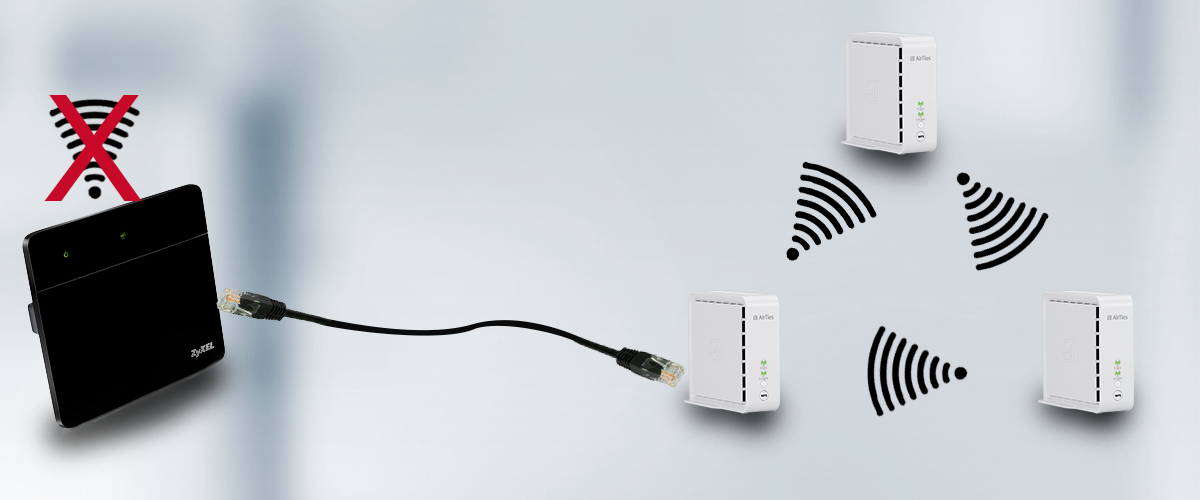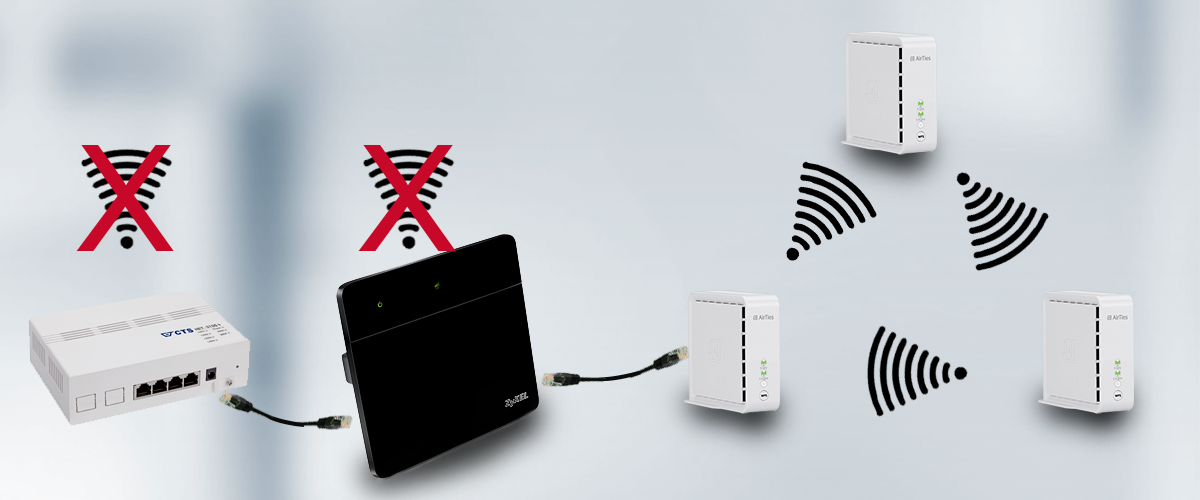Having trouble with your wireless AirTies network? Use this checklist to search for errors in your setup and exclude some of the most common sources of errors.
1. Do both LEDs glow in green on all devices?
Verify that all AirTies access points in the mesh network have a green LED light with a short, slow flash on the 5 GHz indicator.
- If one or more devices have a longer green flash, they are not connected to the mesh or have dropped out. This is best solved by resetting the network. See Resetting AirTies devices (restore factory settings)
- See also Light signals on AirTies home pack – an overview and follow the advice there.
2. Are the AirTies access points properly set up and any other wireless networks in the home turned off?
Check that the Ethernet cable goes to the correct device
One AirTies device should always be connected by Ethernet cable directly to the router — or whichever device is used as a router.
Therefore, if you have a multi-function device with a built-in router, this is the device the AirTies access point should be connected to.

If you have a separate router as well as a modem, the AirTies access point should still be connected to the router.

Turn off wireless radios in other devices
Wireless radios in all devices other than the AirTies access points should be switched off. Log on to your router’s settings and turn off both 2.4 GHz and 5 GHz wireless radios, so that your new wireless network is not disturbed.
3. Have You Kept the SSID and Password Identical for Both Frequency Bands?
Not getting the speed you expect?
Go to http://air4920.local (or http://air4930.local) or use the Airties Wi-Fi app to verify that check that the 2,4 GHz and 5 GHz networks are still set up with identical network names (SSID) and passwords.
With other types of equipment, it is common to set up different SSIDs for the frequency bands, but the band steering in the AirTies mesh network relies on both bands having the same credentials to be able to dynamically give all clients the best best connection at any time.
4. Are the AirTies Devices Well Placed for Coverage?
Use the AirTies WiFi app to check the links between the devices and to the clients.
Check the link between the AirTies devices
Use the app to check whether wireless communication between devices is flowing well. If not, you may need to move them closer together or give them better visibility of each other.
Some home layouts and building materials will be more demanding than others here – see also 10 Things That Interfere with and Block WiFi signals.
Check the link between the client and the access point
Use the app to check how strong the connection is between your clients and the access points they are connected to. If the connection is weak, it may be because the access point is not optimally placed for spreading the coverage. Note that this also depends on the capacity of the client – older smartphones, tablets, and PCs will perform worse than new ones even when the coverage is good.
Advice on placement of AirTies devices can be found in the AirTies Home Pack Placement Guide.
5. Does the Router Have Sufficient IP Addresses to Distribute?
If the client (the computer, mobile phone, tablet), seemingly connects to the network but cannot actually use it, the DHCP server in your router may have run out of internal IP addresses to hand out. It must have enough addresses for all the AirTies devices and all clients on the network to have their own address at all times.
Check whether the client has gotten an IP address
- Windows: Press the Windows key, type “cmd”, and when the terminal window opens, type “ipconfig”. Check which internal IP address is listed.
- Mac or Linux: Open the terminal, type “ifconfig”. Check which internal IP address is listed.
- Android: Settings > About Phone > Status
- iOS (iPhone/iPad): Settings > Wi-Fi > Tap the network you are connected to
You should not have an address beginning with 169.254–the most common ones are: 192.168.1, 192.168.0.n, 172.16.n.n, 10.n.n.n, where n is a number between 0 and 255.
Check your router’s DHCP settings
This varies from manufacturer to manufacturer, but here you have to go into the settings of the router (normally by login via the web) and find the setting for the DHCP scope, DHCP range, or similar.
Once you have found the correct setting, change it to a number that is high enough to include all AirTies devices AND all clients in your home at the same time.